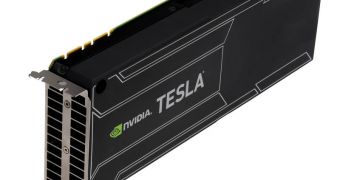The Jaguar supercomputer was at the top of the Top500 list between November 2009 and October 2010, but the past two years have seen it drop quite a bit below that mark. The system is ready to retake its leading position though, under a new name.
Regardless of what vendors of x86 processors say, GPU compute accelerators win easily in terms of raw processing power, especially when they are built well, and NVIDIA's Tesla K20 adapters, based on the Kepler architecture, are powerful indeed.
Seeing this, Cray decided to upgrade the Jaguar with them. The result was a huge HPC (high-performance computing) installation with 18,688 nodes, each featuring a 16-core AMD Opteron 6274 processor and an NVIDIA Tesla K20 graphics processing unit (GPU) accelerator.
That means that there are as many AMD chips as there are GPU compute accelerators, but one should not make the mistake of thinking the workload is evenly divided between the two chip types.
Overall, the Tesla hardware provides 90% out of over 20 million billion floating-point operations per second (total processing capacity).
Previously, we came upon a rumor about the number of AMD-NVIDIA nodes, but the number was quite a bit smaller than the one revealed now (14,592).
It all implies that Cray and NVIDIA have done all they could to break the 20 Petaflop threshold. After all, the long-term goal of the HPC industry is to create 1000-petaflop supercomputers, and Titan is an important milestone in this journey.
It does not hurt one bit that Titan is five times more energy efficient than its predecessor, in addition to 10 times faster at breaking down complex information (Jaguar could achieve 2.3 petaflops).
"You simply can't get these levels of performance, power- and cost-efficiency with conventional CPU-based architectures. Accelerated computing is the best and most realistic approach to enable exascale performance levels within the next decade," said Steve Scott, chief technology officer of the GPU Accelerated Computing business at NVIDIA.
Titan will be used to perform disease studies, material analysis, energy experiments and climate change research. Considering the new Frankenstorm that has been scaring meteorologists into talking about the Apocalypse, that last scientific field may show increased activity soon.

 14 DAY TRIAL //
14 DAY TRIAL //